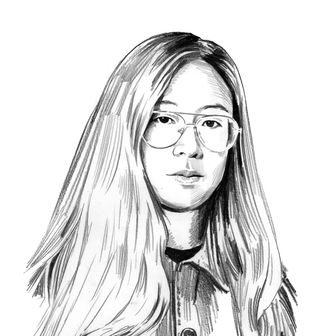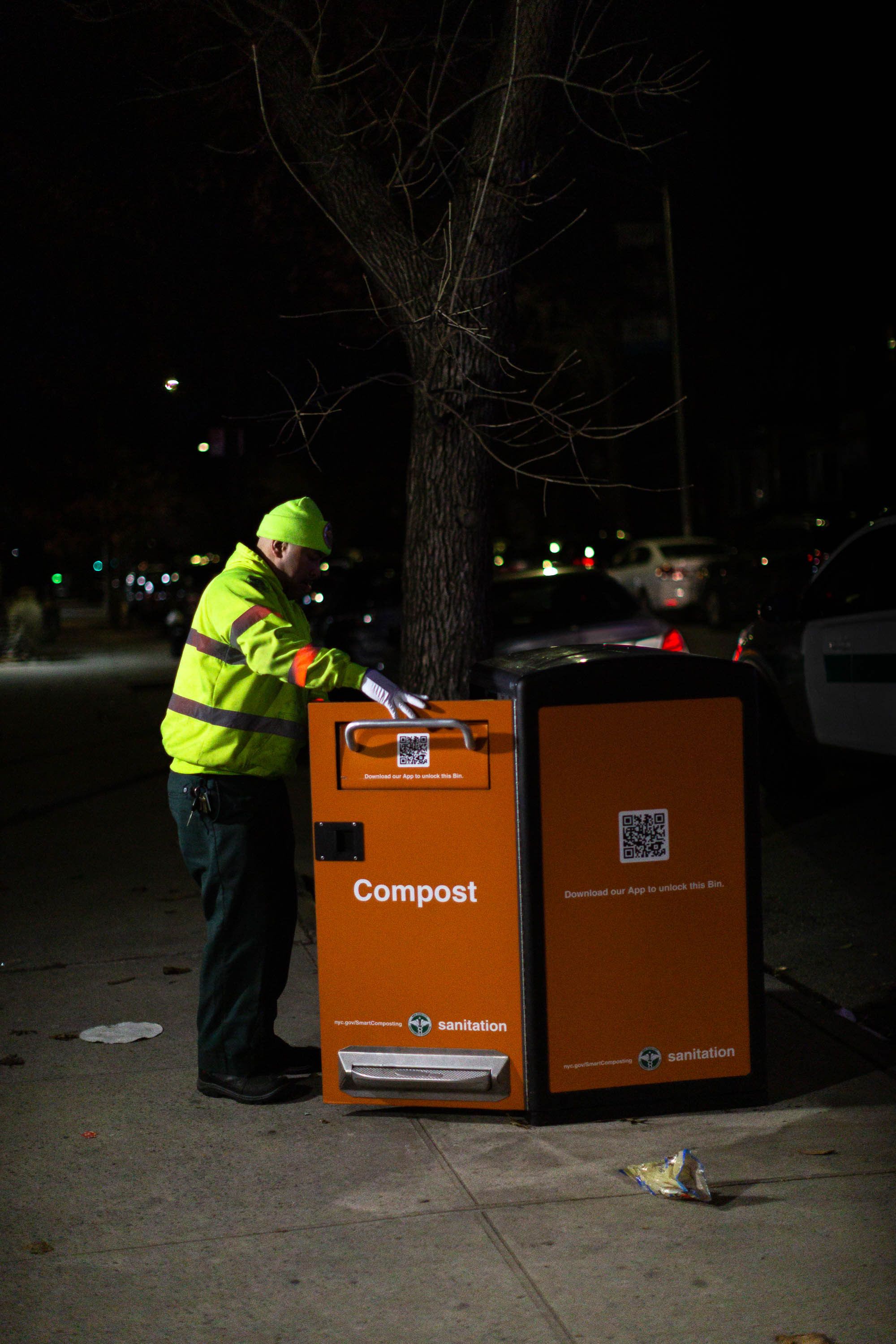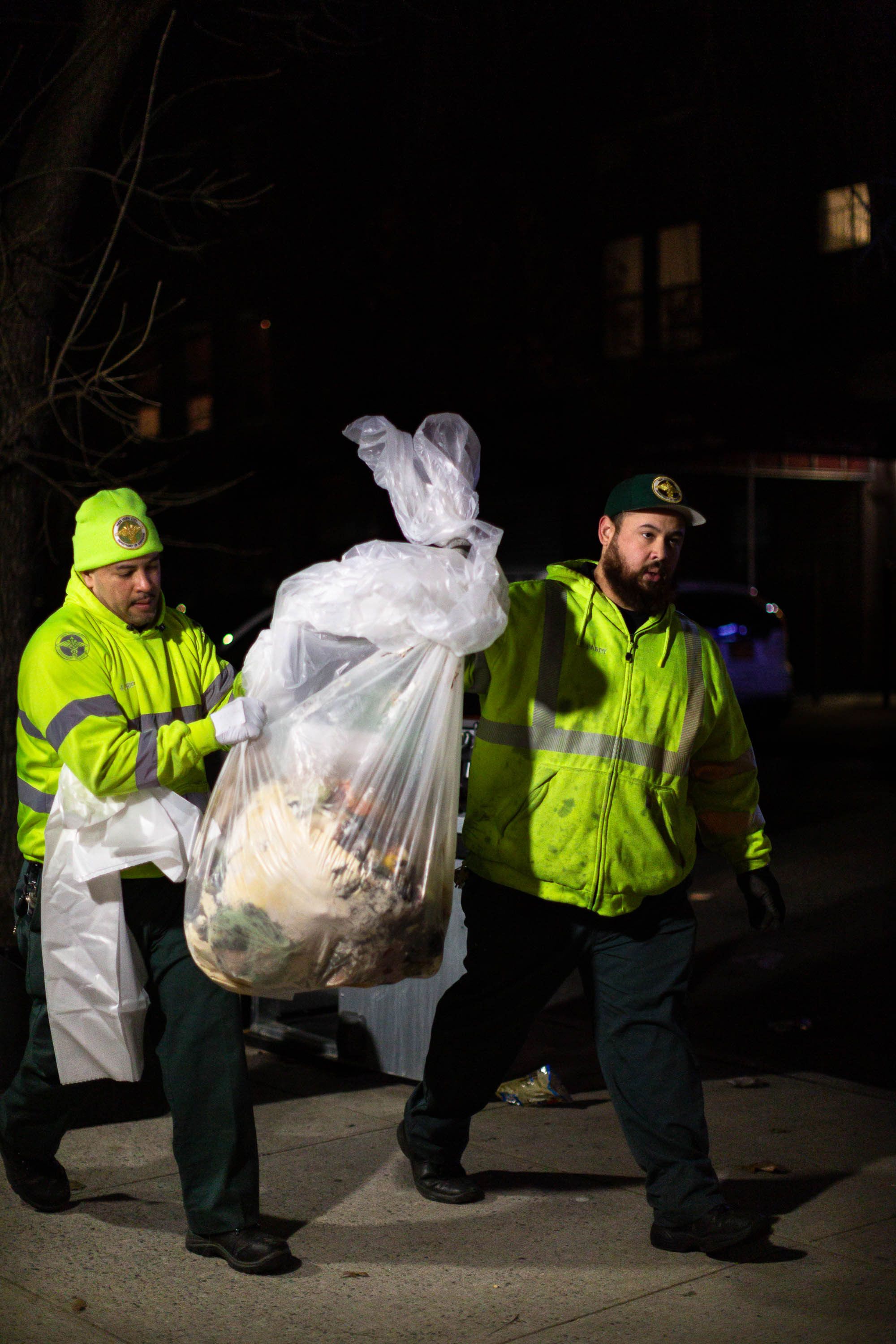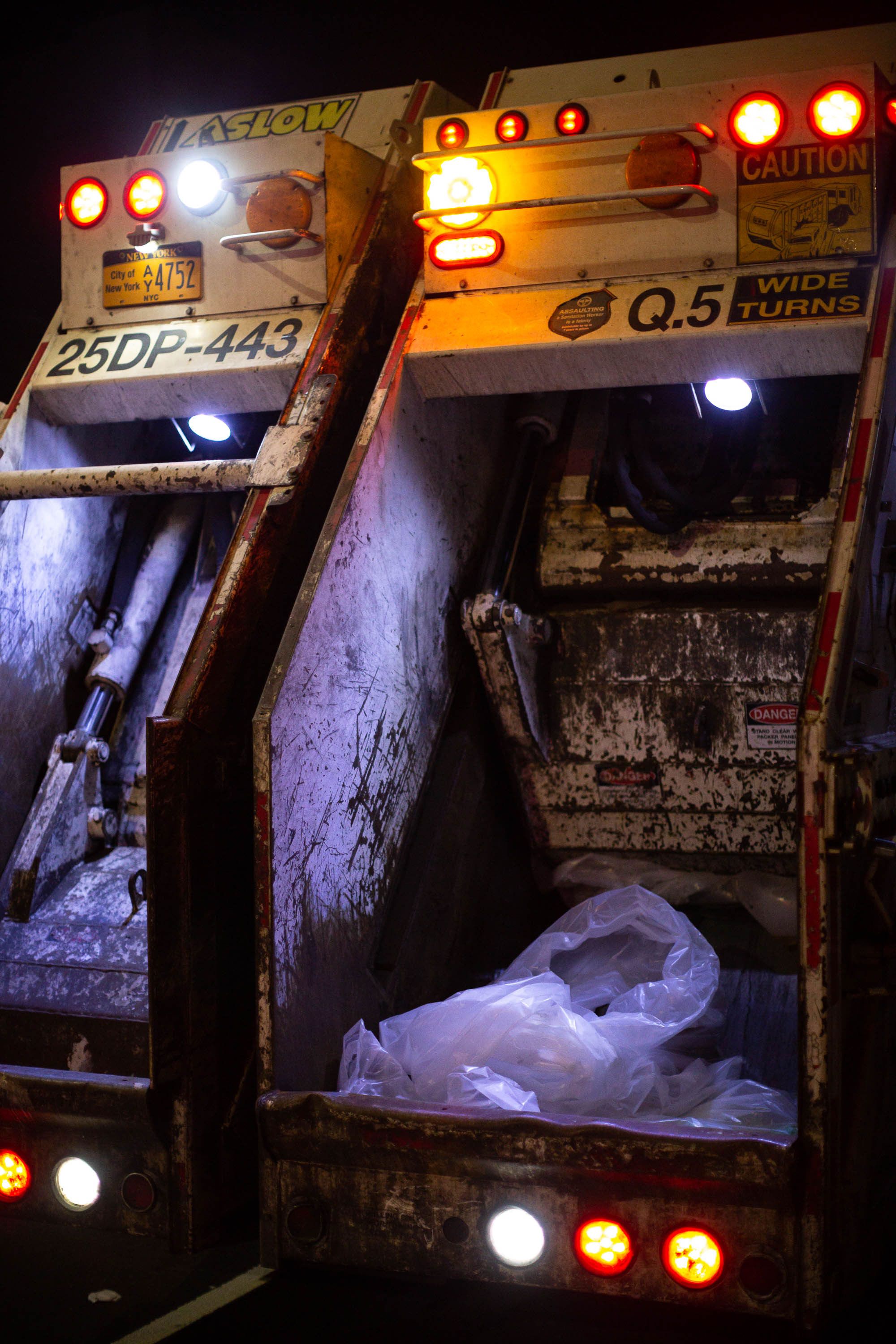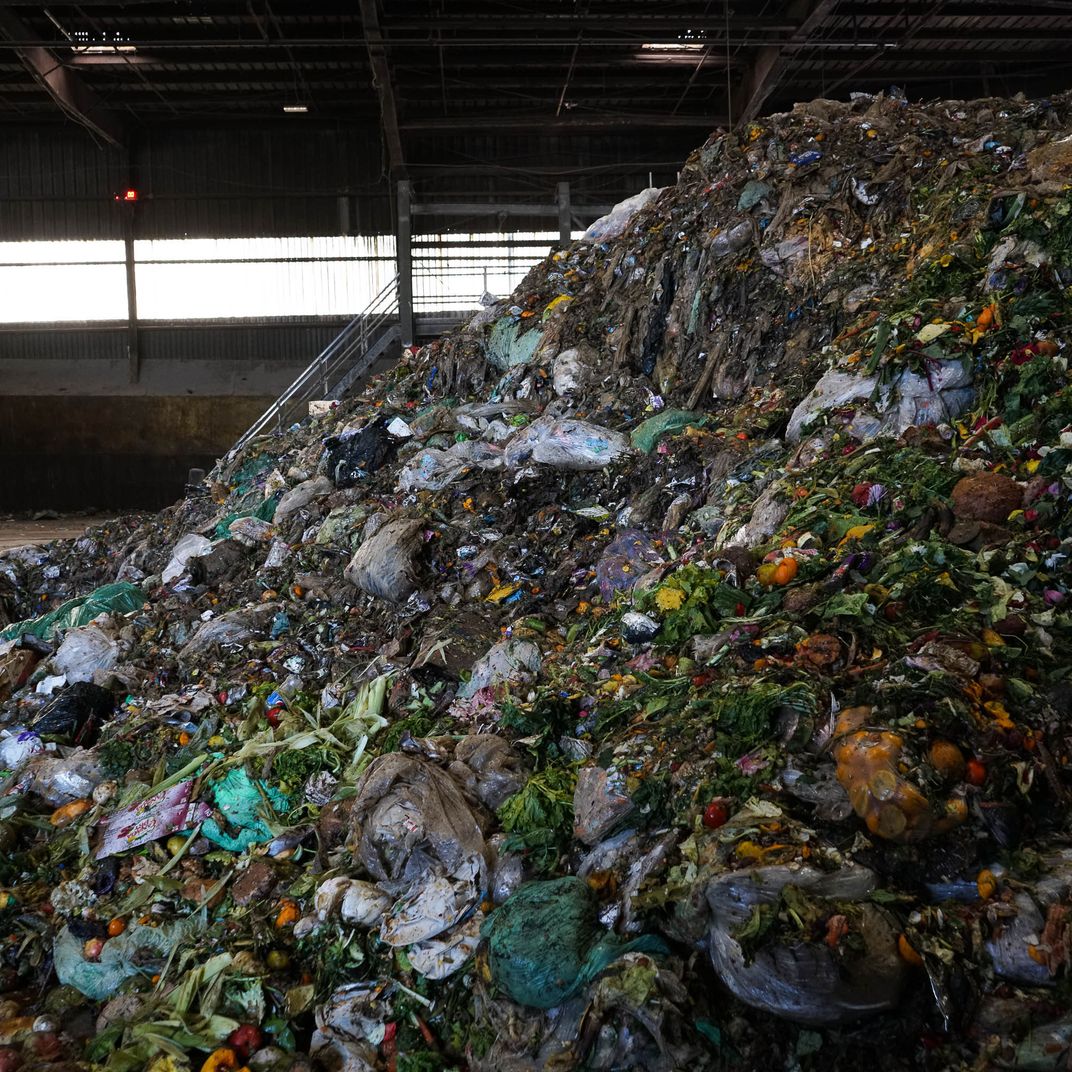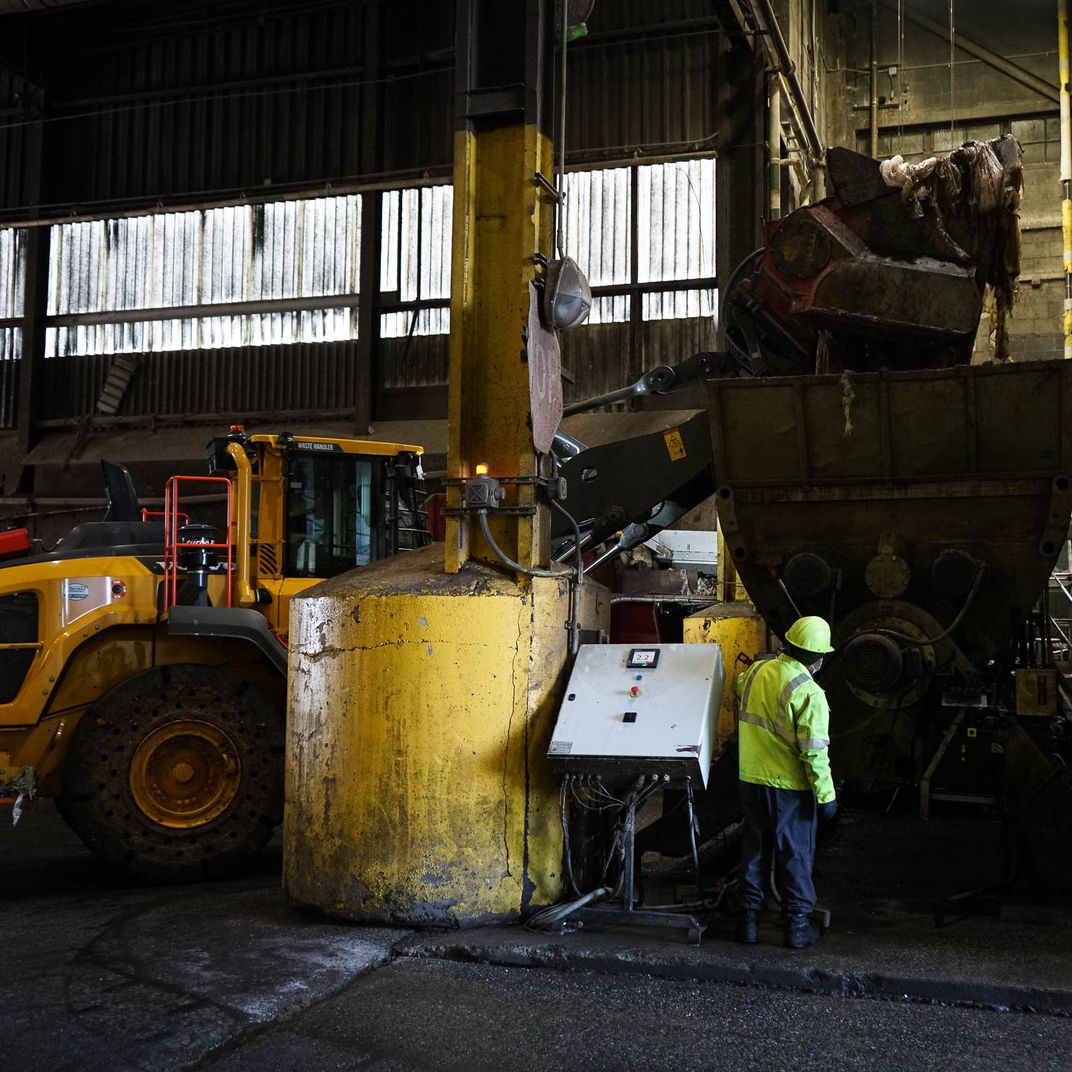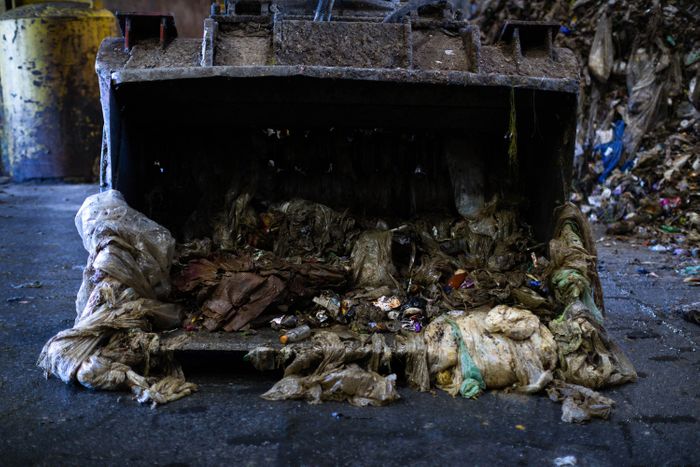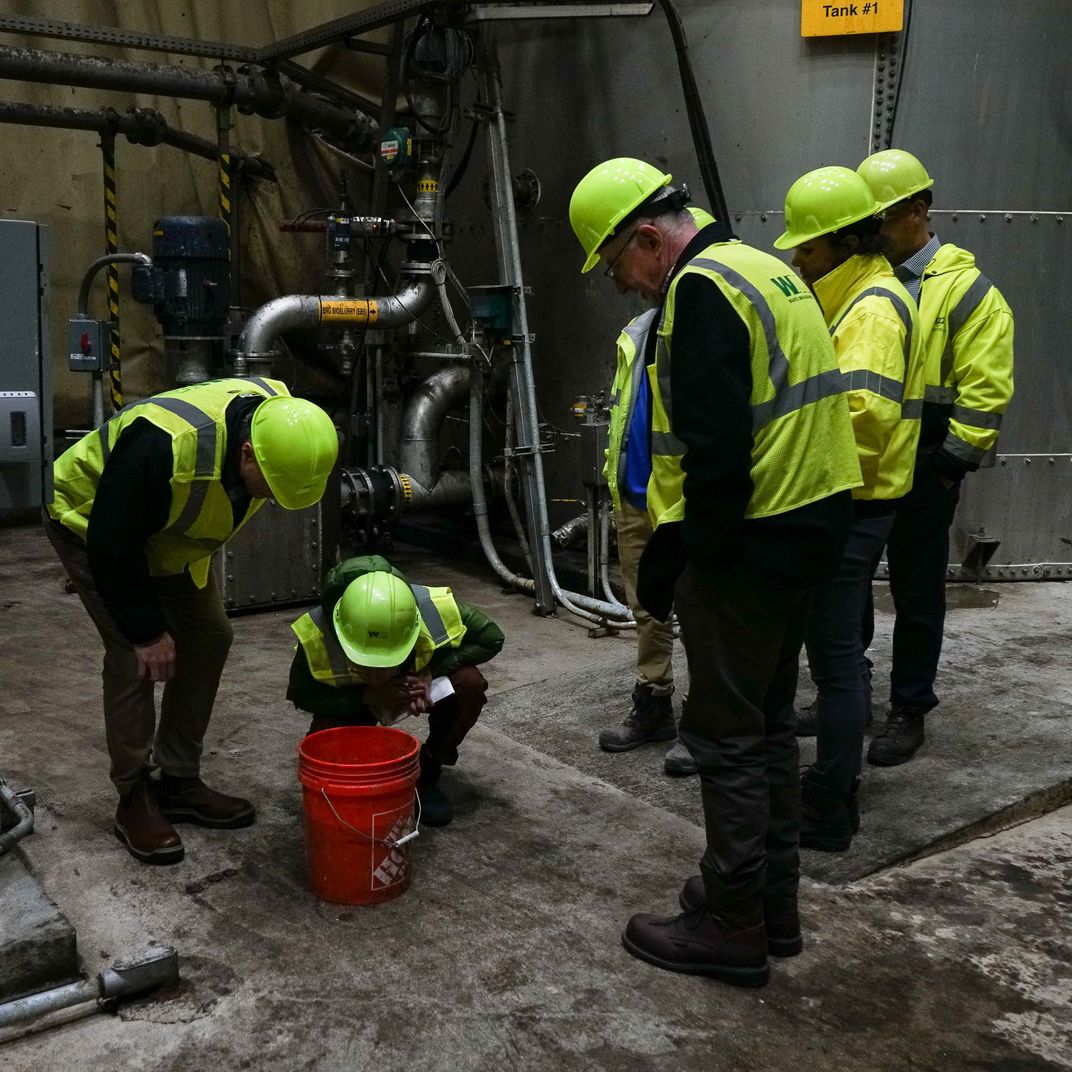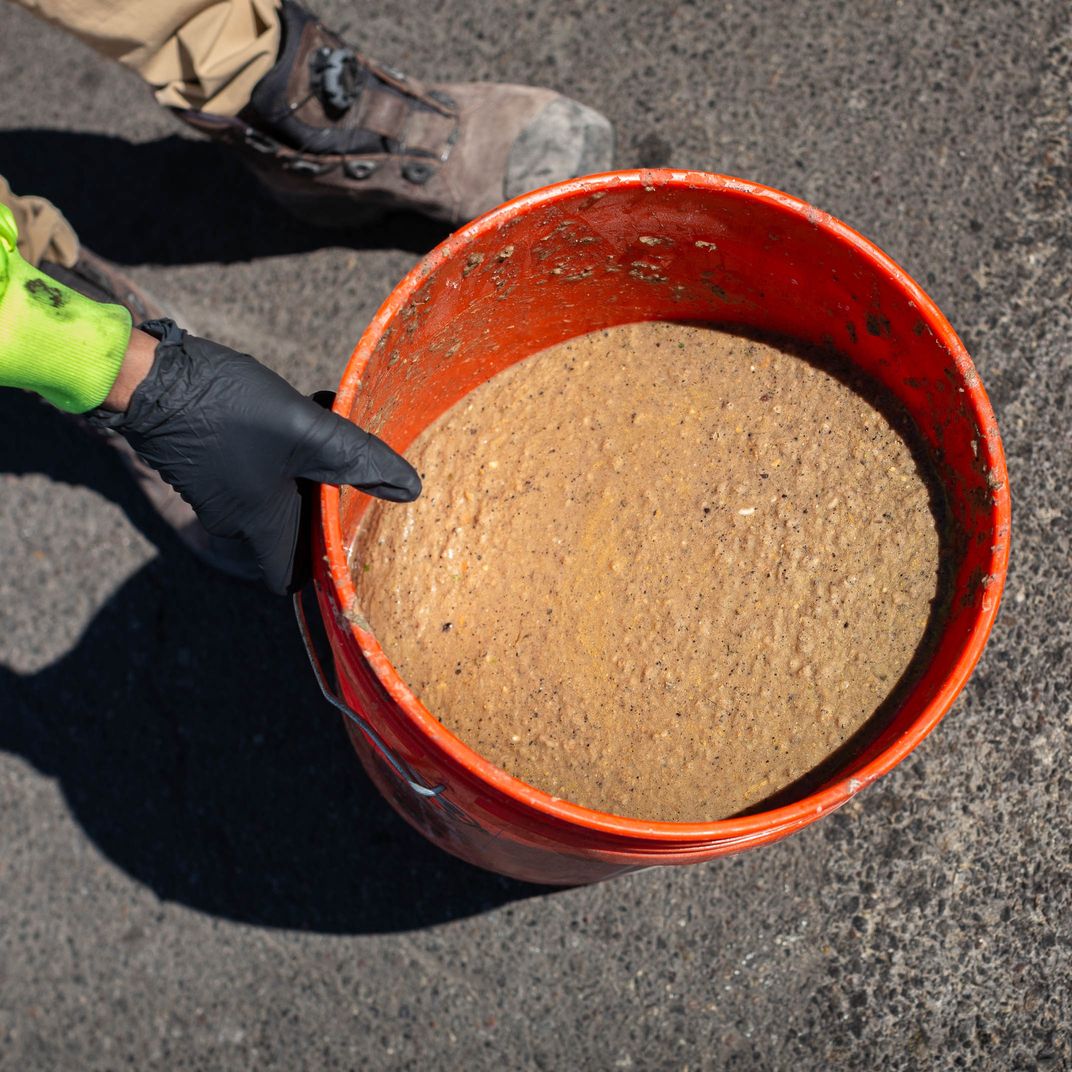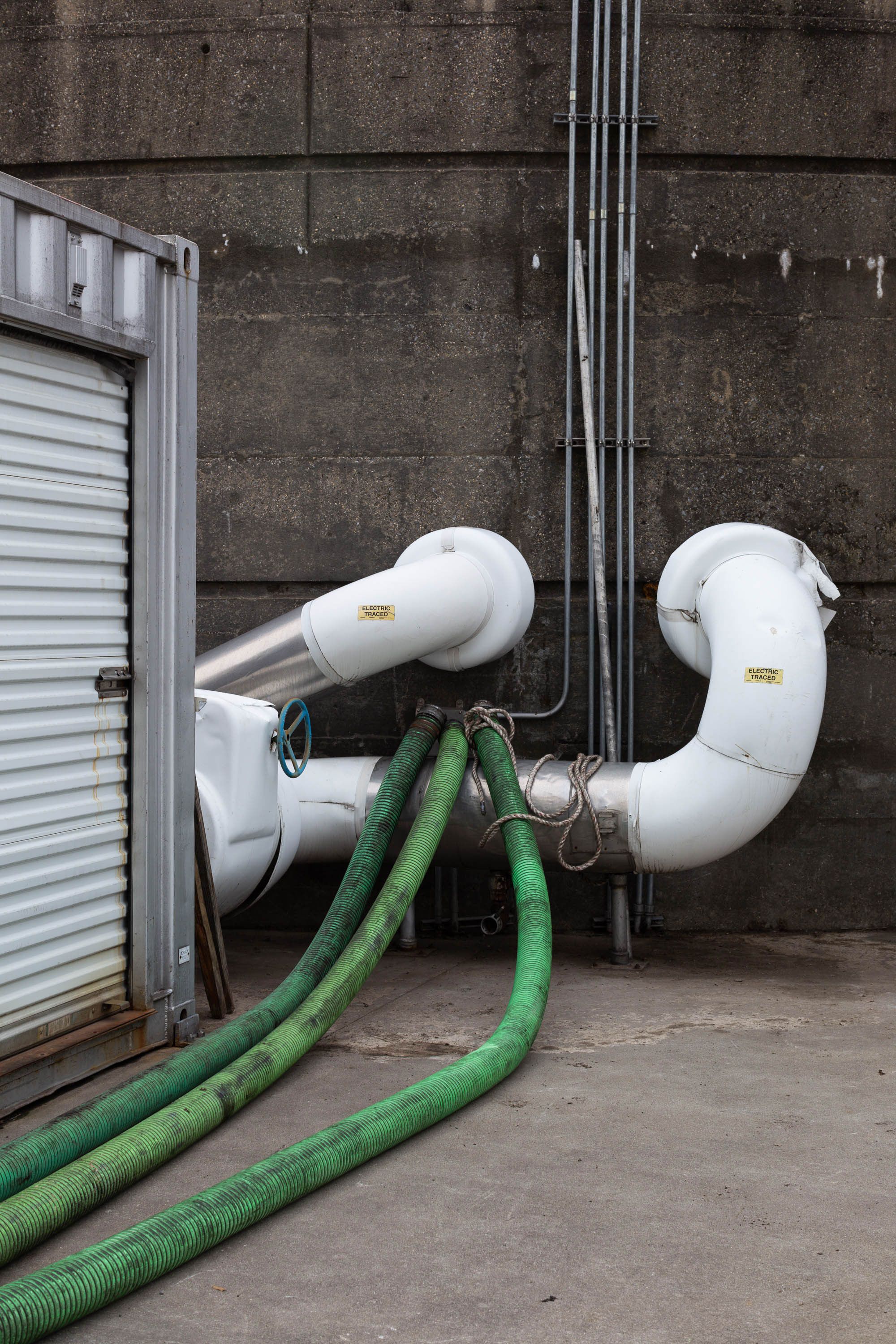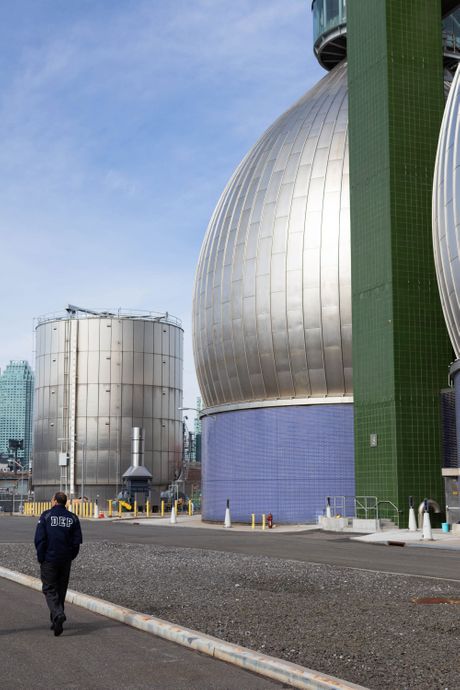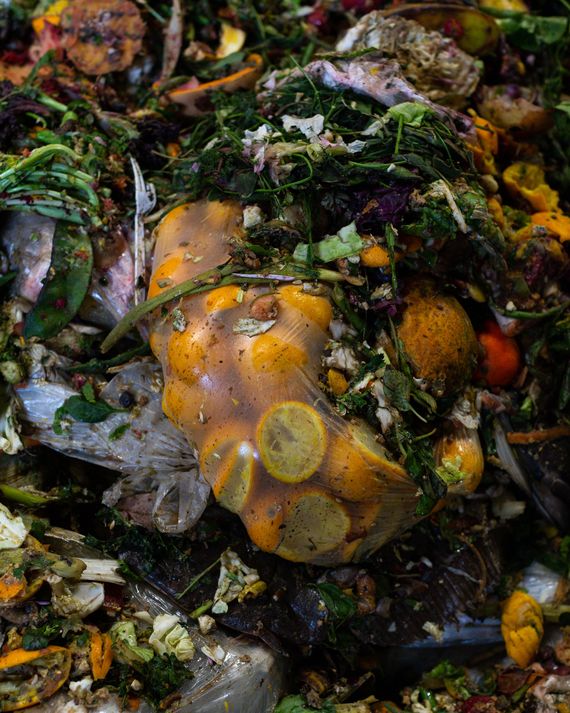
Emptying a Smart Bin takes about 45 seconds. One sanitation worker unlocks the ruddy orange container with a swipe of his hand, using a keycard tucked into his glove. A door at the front of the bin springs open with a click and he removes a large bag of food scraps, turning around to toss it into the truck’s hopper. His partner wordlessly replaces him in front of the bin, bending down as he shakes out a new plastic liner to place inside. He closes the door brusquely, hops back into the truck, and it rumbles on to the next. The whole thing looks like a well-rehearsed heist.
Or maybe it just feels that way because it’s midnight, the streets are virtually empty, and I’m wired as we follow them in a small car driven by DSNY Superintendent Anthony Innone. (The compost recently switched over to an overnight shift, which has the bonus of less traffic.) “Fast,” I tell him. “Yeah, they’re quick,” he says. I’m not allowed to ride in the actual truck, so Innone, a quick talker who has worked with DSNY for 11 years, has agreed to drive me around a collection route in Astoria as a kind of compost babysitter. The Smart Bins being emptied are one piece of the city’s much-heralded plan to bring composting to all five boroughs, and I’m here to follow these precious, semi-frozen bundles to see where they end up. It’s a process that will ultimately include three different facilities, two public agencies, two private companies, and a lot of anxious public-relations employees. And even though “COMPOST” is written on the front of the Smart Bins, our journey will not include any compost.
By 1 a.m. and about 12 blocks and a similar number of bins away from where we started, Innone offers to drop me at the subway. The sanitation workers will continue their shift into the early morning, but we agree I have gotten the gist. It’s already late and I’ve decided to pace myself. There’s a long way to go.
A few days later, I’m in Williamsburg at a transfer station on Varick Street, trying not to get hit by a truck. “You can’t hang out here,” a man tells me from the window of his truck as I approach the entrance. “It’s not safe.” I agree, noticing that no one else is on foot, and try to shadow his truck, like I’m also a truck, as he rolls into the back of the building. This is the dump zone, and I can smell it before I see it.
The facility, a cavernous warehouse that smells like sulfur, is run by Waste Management, a privately operated company with a very straightforward name that is the biggest landfill operator in North America. The company’s Varick plant processes a third of Brooklyn’s total trash, and it’s also where 200 tons of the city’s food waste goes every day, piled up into a mountain, including all of the Smart Bin waste outside of Staten Island.
This is the sorting phase of the process, and no fewer than six Waste Management employees have been assembled to take me around. First, we watch as the trucks line up to be weighed, since customers pay by weight to dump. “Is it priced by pound?” I ask. “Tons,” everyone responds in unison, and we all laugh at my inability to grasp orders of magnitude. One-third of the residential trash — some 4,000 tons daily — that New Yorkers throw away is food or yard waste that could be diverted from methane-emitting landfills. The heap of food scraps we are looking at, which has cartoon-like steam rising off the top, is massive, but only constitutes a tiny fraction of what it could be. There are pigeons resting and scavenging on its peak. Darryll Persad, the site manager, tells me that they have an air-filtration system and a deodorizer that puts out a scent to help control the odor. There are multiple scents to choose from, but Persad says, with a decisiveness that I can only dream of, that he “just orders cinnamon.” (Since all I smell is trash, I’ll just have to take his word for it.)
For decades, New York has lagged behind other cities in scaling up its composting efforts, which mostly included community garden drop-offs and a few curbside pickup zones in select neighborhoods. But this February, after starting and pausing a pilot in Queens, Eric Adams announced that curbside composting would be coming to all five boroughs by the end of 2024. Nearly 250 Smart Bins were placed around the city with more to come, as a complementary effort to the city-provided brown bins, and they have come to serve as the most immediately visible part of New York’s new composting landscape. The city took great pains to try to keep regular trash out of the street-corner receptacles; the Smart Bins are locked and can only be opened with an app. After they were installed, I started freezing my own compost and bringing it to the bins, even though the closest one was still a 30-minute walk away.
The city has multiple streams for its organic waste, including a Staten Island composting facility that takes in material from food scrap drop-off sites and the borough’s Smart Bins and schools, and a New Jersey compost facility that takes in woody debris. But much of the rest goes through Waste Management, whose job it is to separate the food scraps from contaminants, which can include anything from plastic bags to oscillating fans. (Years ago, an entire pig from a pig roast had to be removed because it was too bulky.) We’re standing at the pile of scraps as a payloader truck picks up the organic waste, shredding it and taking out any larger unwanted items. Then it’s dropped into a series of Mousetrap-like machines that spit out any leftover contaminants onto a conveyor belt. “Then we squeeze the daylight out of it,” Dan Hagen, business-development manager, says of the discarded heap of plastic bags. It’s a beautiful and disgusting cycle: The water that’s pressed out is added back into the food waste to help liquefy it.
The resulting muck is not compost. Nor is it soil. It is, I’m told, EBS®. “What is EBS®?” I asked. “Engineered bioslurry,” my Waste Management guides tell me, a product of their proprietary system. (Later, John Hambrose, Waste Management’s spokesperson, emails me to make sure I call the product EBS®.) There are two 60,000-gallon tanks full of engineered bioslurry that are in the same space, but kept behind a white curtain like ladies in a changing room. The people at Waste Management have kindly pulled out a Home Depot bucket and filled it with the chocolate-milk-colored slurry so we can examine it. “It looks like bisque,” Hambrose observes as we peer into the bucket.
The slurry is then piped into tanker trucks and they drive from Williamsburg to the Newtown Creek wastewater treatment plant in Greenpoint, which is run by the Department of Environmental Protection. The plant is an imposing part of Brooklyn’s landscape, famous for its eight plump, 185-foot-high anaerobic digester “eggs” that tower in front of us. (Plant chief Steven Cubero says employees use bicycles to get around.) This is where the slurry will get turned into its final state — methane.
The Waste Management trucks are connected to a gigantic concrete tank and the slurry is pumped in where it travels underground to then be mixed into the sewage and distributed to four of the eggs. “Everyone will get splashed with the sludge at some point,” Cubero says. “It’s a kind of baptism.” When I ask if he’s ever personally been splashed by sludge on the job, he nods vigorously. “Oh, of course,” he said. “I wouldn’t be the chief unless I was.” (Crucially, there are showers on site.) The insides of the eggs are kept at 98 degrees, which DEP employees unsettlingly keep reminding us is the same temperature as the human body, and the waste gets anaerobically digested, in which bacteria in the eggs break down the material without oxygen. The solids get significantly reduced and the rest becomes methane. This methane can be turned into biogas — essentially synthetic natural gas — which is the ultimate product of all this processing. Half of the methane is currently being used to power the Newtown Creek facility itself, while the other half is being burned, releasing carbon dioxide into the air. (About one-third of the leftover solids from the digester do get composted.)
We peer into a Home Depot bucket filled with bioslurry.
The engineered bioslurry is thick and tan-colored.
The bioslurry gets driven to Newtown Creek’s Wastewater Treatment Plant, where it’s piped into a concrete tank.
We peer into a Home Depot bucket filled with bioslurry.
The engineered bioslurry is thick and tan-colored.
The bioslurry gets driven to Newtown Creek’s Wastewater Treatment Plant, where it’s piped into a concrete tank.
Ultimately, the plan is for Newtown Creek’s excess methane to be purified by National Grid so it can be piped into its general natural-gas supply to heat homes. The project began under the Bloomberg administration in 2013 and has been long delayed, to the chagrin of many. But as we stand in the shadow of the great eggs, we’re told that National Grid is in the final stages of the project and that it should be completed “really soon.” In the moment, however, we are shuffled away from the tank where the biogas is imminently supposed to go by a DEP spokesperson because it’s “not in service yet.”
Some environmentalists and experts have called this part of the city’s composting program greenwashing. Biogas is branded by the gas industry as “renewable energy,” which obscures the fact that the result is still natural gas that produces emissions when burned. “There’s a risk that with this sort of availability of biogas, people are not going to see the point of replacing boilers and furnaces,” which is the real necessary goal, says Laura Feinstein, a researcher at the nonprofit Sightline Institute. Especially when there is another option for all that food waste — actual composting — which doesn’t emit methane at all and turns our waste into soil.
Jessica Tisch, DSNY commissioner, says that getting organics out of landfills is “goal number one,” but they’re also putting out an RFP to analyze their processing options. “One of the things we are looking to do is to strike an appropriate balance between composting and anaerobic digestion.” The city has a number of factors to consider, like taking into account different sites’ capacities, making sure certain neighborhoods are not overburdened with processing food waste, and optimizing transportation routes to minimize truck traffic. The DEP commissioner on our Newtown Creek tour also noted that composting is “space intensive” and the digester allows the city to process more of its organic waste within the city, rather than transporting it to another location, as it does for much of its trash.
As we stroll toward Newtown Creek’s gates, we’re almost four miles away from the orange Smart Bin in Queens where I started. In theory, composting, which is something that the Earth has done naturally since before humans invented the concept of time, should be simple, so I thought that my journey would be as well. But in a city of 8 million people, nothing is ever quite so easy. Over the last few weeks, I have watched our food waste move from bin to pile to egg, changing from solid to proprietary liquid to gas, ultimately becoming a fuel that powers the machines that make more of it. It’s not exactly the virtuous cycle I had imagined, but neither is it still rotting in a landfill. In some ways, it feels like I have been baptized, too.


